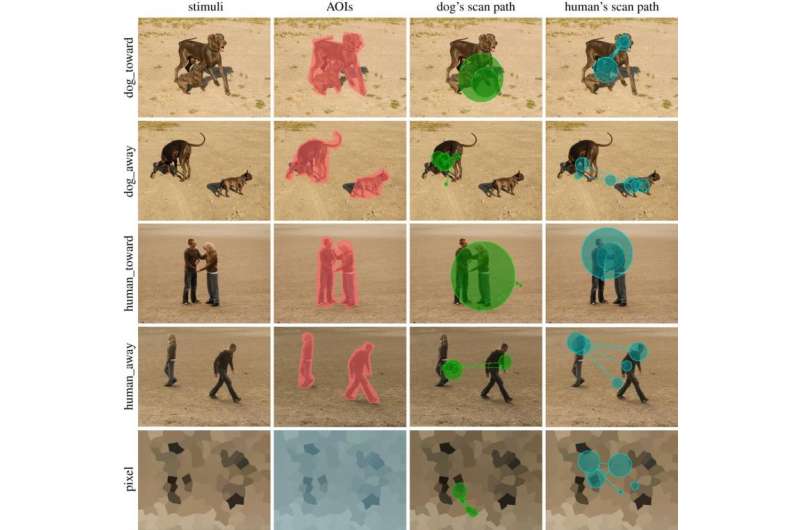September 30, 2015 report
Study show similarities and differences in gazing between humans and dogs

(Phys.org)—A study conducted by animal researchers at the University of Helsinki, has found that there are both similarities and differences in the ways humans versus dogs gaze at other people or dogs interacting. In their paper published in Royal Society Open Science, the group describes the study they carried out and what they found as a result.
Scientists and anyone who has been around dogs have known for quite some time that there are definite similarities between the way humans and dogs gaze at things, but until now, the researchers report, no real studies have been conducted to pin down just how the behaviors compare between the two species.
To learn more, the researchers rounded up 46 dogs (some from homes and some from kennels) and 26 humans, some of which were professional dog trainers. They then set up a device capable of tracking eye movements of either species and then studied eye movement as individuals from either group were given different scenes to stare at—all of which involved watching pairs of either dogs or people interacting. The researchers set up two kinds of scenes, one where two people or dogs were hugging or interacting directly and another where they were walking away from one another.
In studying the results, the researchers found that both species tended to hold their gaze longer when gazing at dogs or people interacting, than for those looking away from each other, but they also found that dogs tended to gaze longer and move their eyes more when looking at humans interacting, while humans tended to focus longer on dogs interacting. This might be, the researchers suggest, because it takes more work for one species to ascertain the mood or try to guess how a member of another species might behave, than when looking at members of their own kind. The researchers also found that there was little difference between the gazes of dog experts and non-experts and that there was a slight difference between the amount of gazing by kennel dogs versus family pets. This, they suggest, indicates that the processing of social stimuli by members of each groups is essentially the same.
More information: Comparison of dogs and humans in visual scanning of social interaction, Royal Society Open Science, Published 30 September 2015.DOI: 10.1098/rsos.150341
Abstract
Previous studies have demonstrated similarities in gazing behaviour of dogs and humans, but comparisons under similar conditions are rare, and little is known about dogs' visual attention to social scenes. Here, we recorded the eye gaze of dogs while they viewed images containing two humans or dogs either interacting socially or facing away: the results were compared with equivalent data measured from humans. Furthermore, we compared the gazing behaviour of two dog and two human populations with different social experiences: family and kennel dogs; dog experts and non-experts. Dogs' gazing behaviour was similar to humans: both species gazed longer at the actors in social interaction than in non-social images. However, humans gazed longer at the actors in dog than human social interaction images, whereas dogs gazed longer at the actors in human than dog social interaction images. Both species also made more saccades between actors in images representing non-conspecifics, which could indicate that processing social interaction of non-conspecifics may be more demanding. Dog experts and non-experts viewed the images very similarly. Kennel dogs viewed images less than family dogs, but otherwise their gazing behaviour did not differ, indicating that the basic processing of social stimuli remains similar regardless of social experiences.
Journal information: Royal Society Open Science
© 2015 Phys.org




















